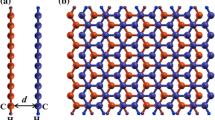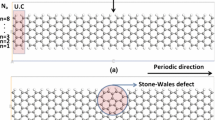Abstract
The framework of the tight-binding model and Green’s function formalism have been derived to investigate the electronic properties of few-layer T-graphene nanoribbons (TGNRs) with different edges including zigzag, bearded, and armchair TGNR (zTGNR, bTGNR, and aTGNR) and the results are compared with those of monolayers. It was observed that single-layer zTGNRs and bTGNRs with metallic properties retain this characteristic as the number of layers increases. In addition, by virtue of their mirror symmetry, aTGNR monolayers exhibit metallic and semiconducting properties by even and odd widths, respectively. When layers are added, symmetric aTGNRs display metallic behavior, while asymmetric aTGNRs display metallic and semiconducting characteristics, depending on the layer stacking. It is also found that the band structure of symmetric aTGNRs and metallic few-layer asymmetric aTGNRs contain Dirac points which increase with increasing their width and layers.















Similar content being viewed by others
Data availability statement
The datasets analyzed during the current study are available from the corresponding author on reasonable request.
References
H.W. Kroto, J.R. Heath, S.C. O’Brien, R.F. Curl, R.E. Smalley, C60: Buckminsterfullerene. Nature 318(6042), 162–163 (1985)
S. Iijima, Helical microtubules of graphitic carbon. Nature 354(6348), 56–58 (1991)
K.S. Novoselov, A.K. Geim, S.V. Morozov, D.-E. Jiang, Y. Zhang, S.V. Dubonos, I.V. Grigorieva, A.A. Firsov, Electric field effect in atomically thin carbon films. Science 306(5696), 666–669 (2004)
K.S. Novoselov, A.K. Geim, S.V. Morozov, D. Jiang, M.I. Katsnelson, I. Grigorieva, S. Dubonos, A. Firsov, Two-dimensional gas of massless dirac fermions in graphene. Nature 438(7065), 197–200 (2005)
A.K. Geim, Graphene: status and prospects. Science 324(5934), 1530–1534 (2009)
A.C. Neto, F. Guinea, N.M. Peres, K.S. Novoselov, A.K. Geim, The electronic properties of graphene. Rev. Modern Phys. 81(1), 109 (2009)
Y. Zhang, Y.-W. Tan, H.L. Stormer, P. Kim, Experimental observation of the quantum hall effect and berry’s phase in graphene. Nature 438(7065), 201–204 (2005)
Z. Jiang, Y. Zhang, Y.-W. Tan, H. Stormer, P. Kim, Quantum hall effect in graphene. Solid State Commun. 143(1–2), 14–19 (2007)
H. Mousavi, J. Khodadadi, M. Grabowski, Semiconducting behavior of substitutionally doped bilayer graphene. Physica B: Condens. Matter 530, 90–94 (2018)
H. Mousavi, Graphene susceptibility in holstein model. J. Magn. Magn. Mater. 323(11), 1537–1540 (2011)
H. Mousavi, The impact of gas molecule adsorption on the orbital magnetic susceptibility of graphene. J. Magn. Magn. Mater. 322(17), 2533–2536 (2010)
H. Mousavi, J. Khodadadi, Graphene to graphane: two-band approach. Superlattices Microstruct. 88, 434–441 (2015)
J. Chen, J. Xi, D. Wang, Z. Shuai, Carrier mobility in graphyne should be even larger than that in graphene: a theoretical prediction. J. Phys. Chem. Lett. 4(9), 1443–1448 (2013)
G. Li, Y. Li, H. Liu, Y. Guo, Y. Li, D. Zhu, Architecture of graphdiyne nanoscale films. Chem. Commun. 46(19), 3256–3258 (2010)
L.-C. Xu, R.-Z. Wang, M.-S. Miao, X.-L. Wei, Y.-P. Chen, H. Yan, W.-M. Lau, L.-M. Liu, Y.-M. Ma, Two dimensional dirac carbon allotropes from graphene. Nanoscale 6(2), 1113–1118 (2014)
Y. Liu, G. Wang, Q. Huang, L. Guo, X. Chen, Structural and electronic properties of t graphene: a two-dimensional carbon allotrope with tetrarings. Phys. Rev. Lett. 108(22), 225505 (2012)
D. Bhattacharya, D. Jana, Twin t-graphene: a new semiconducting 2d carbon allotrope. Phys. Chem. Chem. Phys. 22(18), 10286–10294 (2020)
S.S. Sani, H. Mousavi, M. Asshabi, S. Jalilvand, Electronic properties of graphyne and graphdiyne in tight-binding model. ECS J. Solid State Sci. Technol. 9(3), 031003 (2020)
A.N. Enyashin, A.L. Ivanovskii, Graphene allotropes. Physica Status Solidi (b) 248(8), 1879–1883 (2011)
B.G. Kim, J.Y. Jo, H. Sim, Comment on “structural and electronic properties of t graphene: a two-dimensional carbon allotrope with tetrarings’’. Phys. Rev. Lett. 110(2), 029601 (2013)
X. Zhang, L. Jin, X. Dai, G. Chen, G. Liu, A record-high ion storage capacity of t-graphene as two-dimensional anode material for li-ion and na-ion batteries. Appl. Surf. Sci. 527, 146849 (2020)
Q. Gu, D. Xing, J. Sun, Superconducting single-layer t-graphene and novel synthesis routes. Chin. Phys. Lett. 36(9), 097401 (2019)
S. Ghosal, D. Jana, Beyond t-graphene: two-dimensional tetragonal allotropes and their potential applications. Appl. Phys. Rev. 9(2), 021314 (2022)
K. Wakabayashi, K.-I. Sasaki, T. Nakanishi, T. Enoki, Electronic states of graphene nanoribbons and analytical solutions. Sci. Technol. Adv. Mater. 11(5), 054504 (2010)
H. Mousavi, S. Jalilvand, J.M. Kurdestany, M. Grabowski, Electron doping effects on the electrical conductivity of zigzag carbon nanotubes and corresponding unzipped armchair graphene nanoribbons. Physica E: Low-dimens. Syst. Nanostructures 94, 87–91 (2017)
X.-Q. Wang, H.-D. Li, J.-T. Wang, Structural stabilities and electronic properties of planar \({{\rm C}} _{4}\) carbon sheet and nanoribbons. Phys. Chem. Chem. Phys. 14(31), 11107–11111 (2012)
C. Dai, X. Yan, Y. Xiao, Y. Guo, Electronic and transport properties of t-graphene nanoribbon: symmetry-dependent multiple dirac points, negative differential resistance and linear current-bias characteristics. EPL (Europhys. Lett.) 107(3), 37004 (2014)
D. Klein, Graphitic polymer strips with edge states. Chem. Phys. Lett. 217(3), 261–265 (1994)
Y. Plotnik, M.C. Rechtsman, D. Song, M. Heinrich, J.M. Zeuner, S. Nolte, Y. Lumer, N. Malkova, J. Xu, A. Szameit et al., Observation of unconventional edge states in ‘photonic graphene’. Nat. Mater. 13(1), 57–62 (2014)
S. Freeney, J. van Den Broeke, A.H. van der Veen, I. Swart, C.M. Smith, Edge-dependent topology in kekulé lattices. Phys. Rev. Lett. 124(23), 236404 (2020)
J. Kotakoski, A. Krasheninnikov, U. Kaiser, J. Meyer, From point defects in graphene to two-dimensional amorphous carbon. Phys. Rev. Lett. 106(10), 105505 (2011)
J. Lahiri, Y. Lin, P. Bozkurt, I.I. Oleynik, M. Batzill, An extended defect in graphene as a metallic wire. Nat. Nanotechnol. 5(5), 326–329 (2010)
S. Ghosal, S. Chowdhury, D. Jana, Electronic and thermal transport in novel carbon-based bilayer with tetragonal rings: a combined study using first-principles and machine learning approach. Phys. Chem. Chem. Phys. 23(27), 14608–14616 (2021)
H. Mousavi, S. Jalilvand, S.S. Sani, J.A.L. Hartman, M. Grabowski, Electronic properties of different configurations of double-strand \({{\rm DNA}}\)-like nanowires. Solid State Commun. 319, 113974 (2020)
H. Mousavi, M. Grabowski, Nonlinear electron transport across short \({{\rm DNA}}\) segment between graphene leads. Solid State Commun. 279, 30–33 (2018)
H. Mousavi, J. Khodadadi, M. Grabowski, Electronic properties of long \({{\rm DNA}}\) nanowires in dry and wet conditions. Solid State Commun. 222, 42–48 (2015)
S. Jalilvand, H. Mousavi, Multi-band tight-binding model of \({{\rm MoS}} _{2}\) monolayer. J. Electron. Mater. 49(6), 3599–3608 (2020)
E. Kaxiras, Atomic and Electronic Structure of Solids (Cambridge University Press, Massachusetts, 2003)
G. Grosso, G.P. Parravicini, Solid State Physics (Academic Press, Cambridge, 2013)
S. Jalilvand, R. Sepahvand, H. Mousavi, Electronic behavior of randomly dislocated \({{\rm RNA}}\) and \({{\rm DNA}}\) nanowires: a multi-model approach. Eur. Phys. J. Plus 137(8), 928 (2022)
N. Ashcroft, N. Mermin, Solid State Physics (Harcout College Publishers, USA, 1976)
W.A. Harrison, Electronic structure and the properties of solids: the physics of the chemical bond, Courier Corporation (2012)
Y. Takane, Tunneling density of states in multilayer graphene deposited on a superconductor. J. Phys. Soc. Jpn. 79(12), 124706 (2010)
H. Mousavi, S. Jalilvand, Electrical and thermal conductivities of few-layer armchair graphene nanoribbons. Eur. Phys. J. B 92(1), 1–11 (2019)
C. Lu, C.-P. Chang, Y.-C. Huang, R.-B. Chen, M. Lin, Influence of an electric field on the optical properties of few-layer graphene with ab stacking. Phys. Rev. B 73(14), 144427 (2006)
H. Mousavi, Effects of adsorbed gas on the electrical conductivity of metallic carbon nanotubes. Solid State Commun. 150(15–16), 755–758 (2010)
H. Mousavi, M. Bagheri, Effects of holstein phonons on the electrical conductivity of carbon nanotubes. Physica E: Low-dimens. Syst. Nanostructures 44(7–8), 1722–1724 (2012)
H. Mousavi, S. Jalilvand, J.M. Kurdestany, Pauli magnetic susceptibility of bilayer graphene and hexagonal boron-nitride. Physica B: Conden. Matter 502, 132–139 (2016)
W. Nolting, A. Ramakanth, Quantum Theory of Magnetism (Springer Science & Business Media, Berlin, 2009)
H. Bruus, K. Flensberg, Many-body Quantum Theory in Condensed Matter Physics: An Introduction (OUP Oxford, Oxford, 2004)
H. Mousavi, S. Jalilvand, F. Mirzaei, Magnetic and thermal characteristics of armchair graphene nanoribbons in the two-band harrison model. J. Magn. Magn. Mater. 469, 405–410 (2019)
H. Mousavi, Heat capacity of hexagonal boron nitride sheet in holstein model. Semiconductors 48(5), 617–620 (2014)
H. Mousavi, J. Khodadadi, Electronic heat capacity and thermal conductivity of armchair graphene nanoribbons. Appl. Phys. A 122(1), 1–7 (2016)
A. Bandyopadhyay, A. Nandy, A. Chakrabarti, D. Jana, Optical properties and magnetic flux-induced electronic band tuning of a t-graphene sheet and nanoribbon. Phys. Chem. Chem. Phys. 19(32), 21584–21594 (2017)
Y. Lv, H. Wang, Y. Guo, B. Jiang, Y. Cai, Tetragon-based carbon allotropes t-c8 and its derivatives: a theoretical investigation. Comput. Mater. Sci. 144, 170–175 (2018)
Author information
Authors and Affiliations
Corresponding author
Ethics declarations
Conflict of interest
The authors declare that they have no known competing financial interests or personal relationships that could have appeared to influence the work reported in this paper.
Appendix: TB Hamiltonian matrix for single-layer of bTGNRs and aTGNRs
Appendix: TB Hamiltonian matrix for single-layer of bTGNRs and aTGNRs
We start by calculating the general form of TB Hamiltonian matrix for bTGNRs monolayer. The lattice structure of bTGNR monolayer is shown in Fig. 1b. According to this figure, the BLUC of this structure includes \(N_{a}=4W_{b}+2\) atoms. Therefore, the TB Hamiltonian of single-layer of bTGNR is generally represented by a \(N_{a}\times N_{a}\) matrix:
in which the first row and column, as well as the last row and column, are due to the bearded edges. In addition, \({\varvec{h}}_{0z}({\varvec{k}})\) and \({\varvec{h}}^{\prime }_{z}\) have been introduced previously in Eqs. (7) and (8). In addition, the sub-matrices \({\varvec{h}}^{\prime }_{1b}\) and \({\varvec{h}}^{\prime }_{2b}\) are determined by
According to Fig. 1c, the BLUC of aTGNR monolayer with even width contains \(N_{a}=4W_{a}\) atoms, therefore the TB Hamiltonian of this structure can be generally written as follows:
where the sub-matrix \({\varvec{h}}_{0e}({\varvec{k}})\) is a \(8\times 8\) matrix that is given by
in which \(g({\varvec{k}})=t_{1}\exp \left( \textrm{i}k_{x}a\right)\) with \(a=2a_{1}+\sqrt{2}a_{2}\). Further, the sub-matrix \({\varvec{h}}^{\prime }_{e}\) is also an 8D matrix, with all elements zero except for \({\varvec{h}}^{\prime }(6,5)=t_{1}\) and \({\varvec{h}}^{\prime }(7,8)=t_{1}\).
As it is observed in Fig. 1d, the BLUC of aTGNR monolayer with odd width includes \(N_{a}=4W_{a}\) atoms. Therefore, the general form of the TB Hamiltonian matrix of this structure for each odd width can be shown as follows:
in which the sub-matrices \({\varvec{h}}_{0o}({\varvec{k}})\), \({\varvec{h}}^{\prime }_{0o}({\varvec{k}})\), \({\varvec{h}}^{\prime }_{1o}\), and \({\varvec{h}}^{\prime }_{2o}\) are \(4\times 4\) and equal to, respectively:
Rights and permissions
Springer Nature or its licensor (e.g. a society or other partner) holds exclusive rights to this article under a publishing agreement with the author(s) or other rightsholder(s); author self-archiving of the accepted manuscript version of this article is solely governed by the terms of such publishing agreement and applicable law.
About this article
Cite this article
Mousavi, H., Jalilvand, S. & Paikar, S. A Green’s function-tight-binding-based approach for T-graphene analysis. Appl. Phys. A 129, 195 (2023). https://doi.org/10.1007/s00339-023-06424-4
Received:
Accepted:
Published:
DOI: https://doi.org/10.1007/s00339-023-06424-4




